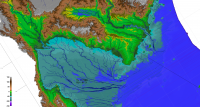CSDMS 2016 annual meeting poster RolfAalto
Quaternary Morphodynamics of Fluvial Dispersal Systems Revealed: The Fly River, PNG, and the Sunda Shelf, SE Asia, simulated with the Massively Parallel GPU-based Model 'GULLEM'
Abstract:
During glacial-marine transgressions vast volumes of sediment are deposited due to the infilling of lowland fluvial systems and shallow shelves, material that is removed during ensuing regressions. Modelling these processes would illuminate system morphodynamics, fluxes, and 'complexity' in response to base level change, yet such problems are computationally formidable. Environmental systems are characterized by strong interconnectivity, yet traditional supercomputers have slow inter-node communication -- whereas rapidly advancing Graphics Processing Unit (GPU) technology offers vastly higher (>100x) bandwidths.
GULLEM (GpU-accelerated Lowland Landscape Evolution Model) employs massively parallel code to simulate coupled fluvial-landscape evolution for complex lowland river systems over large temporal and spatial scales. GULLEM models the accommodation space carved/infilled by representing a range of geomorphic processes, including: river & tributary incision within a multi-directional flow regime, non-linear diffusion, glacial-isostatic flexure, hydraulic geometry, tectonic deformation, sediment production, transport & deposition, and full 3D tracking of all resulting stratigraphy. Model results concur with the Holocene dynamics of the Fly River, PNG -- as documented with dated cores, sonar imaging of floodbasin stratigraphy, and the observations of topographic remnants from LGM conditions. Other supporting research was conducted along the Mekong River, the largest fluvial system of the Sunda Shelf. These and other field data provide tantalizing empirical glimpses into the lowland landscapes of large rivers during glacial-interglacial transitions, observations that can be explored with this powerful numerical model.
GULLEM affords estimates for the timing and flux budgets within the Fly and Sunda Systems, illustrating complex internal system responses to the external forcing of sea level and climate. Furthermore, GULLEM can be applied to most ANY fluvial system to explore processes across a wide range of temporal and spatial scales. The presentation will provide insights (& many animations) illustrating river morphodynamics & resulting landscapes formed as a result of sea level oscillations.
* Please acknowledge the original contributors when you are using this material. If there are any copyright issues, please let us know and we will respond as soon as possible.

